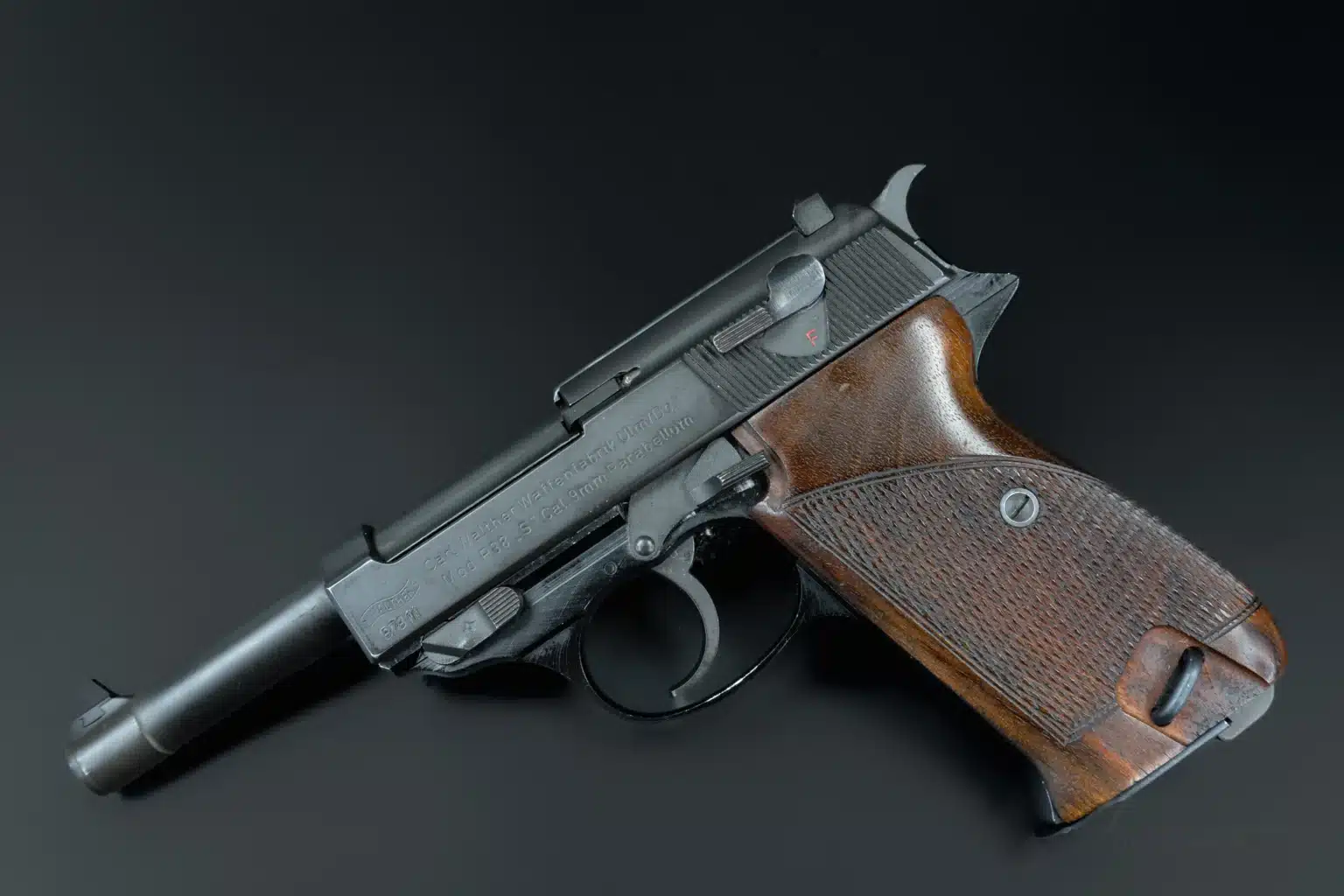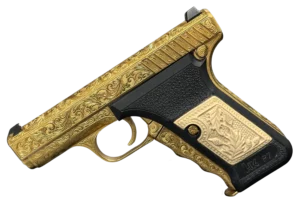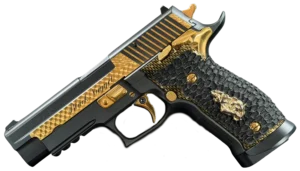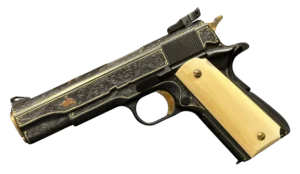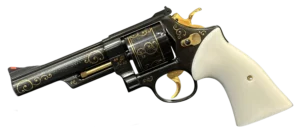Key Takeaways:
- The Walther P38 quietly redefined what a military handgun could be: While the Luger got the spotlight, the P38 did the heavy lifting—introducing practical innovations like the double-action/single-action trigger, a decocker, and a more rugged locking system. It didn’t shout; it just worked. And in war, that kind of quiet reliability speaks louder than flashy mechanics ever could.
- Its legacy isn’t just historical—it’s alive in modern sidearms: If you’ve handled a Beretta 92 or any DA/SA pistol with a decocker, you’ve felt the P38’s DNA. Its influence didn’t end with the war; it spread through police holsters, NATO armories, and civilian gun safes across the globe. Some guns fade after their time. The P38? It laid a blueprint.
- Beyond the battlefield, the P38 became a cultural icon: whether it’s featured in a war film, hidden in the pages of a comic book, or displayed in a collector’s case, the P38 has carved out a space that extends far beyond its technical specifications. It’s not just a pistol—it’s a symbol of an era, an idea, and a shift in how we design for real-world use.
There’s a point in history where a firearm does more than just fire rounds—it changes how we think about handguns entirely. The Walther P38 is one of those rare examples. Developed in the late 1930s as a replacement for the iconic but aging Luger P08, the P38 didn’t just fill a role—it reimagined what a service pistol could be. What emerged from that shift wasn’t just a better gun for its time, but a design that would ripple through decades of firearm development.
It wasn’t flashy, and it wasn’t built to impress on looks alone. The P38 was practical to its core: safer, easier to produce, and more reliable in real-world conditions. If the Luger was a precision instrument, the P38 was a tool built for war. And that’s exactly what it needed to be.
A Smarter, Simpler, Safer Design
When the engineers at Carl Walther Waffenfabrik began work on what would become the P38, they had one big challenge: make something more efficient than the Luger without sacrificing performance. And truthfully? They nailed it.
The P38 brought something almost unheard of at the time—a double-action/single-action (DA/SA) trigger. Sounds technical, but here’s the deal: it meant you could carry the pistol with a round in the chamber, safety off, and still not worry about an accidental discharge. The first trigger pull would be heavier (double-action), cocking and firing in one motion. After that, each shot would be lighter and faster (single-action). For a military sidearm, that was a game-changer.
And the innovations didn’t stop there. Instead of the Luger’s famously finicky toggle-lock system, the P38 used a falling locking block—simpler, sturdier, and much better at dealing with dirt and grit. It could take a beating and still function. That mattered a lot in war zones where ideal conditions were rare and luxury maintenance was nonexistent.
Walther also added a loaded chamber indicator—just a small pin that popped up when a round was chambered, but it meant a soldier could confirm status by touch or glance. That kind of small, thoughtful feature tells you everything about the designers’ mindset: build for function, build for survival.
Designed to Be Used, Not Admired
The P38 wasn’t a showpiece. It wasn’t meant to sit in a polished case or be passed around for admiration. This pistol was designed for use in muddy conditions, freezing winds, or under fire.
Its grip angle felt natural in the hand—less steep than the Luger, more forgiving for different hand sizes. Its sights were basic but effective. The whole platform was balanced in a way that made it quick to draw and fast to shoot. Add in the fact that it was easy to break down and clean, and you’ve got a sidearm that worked with its user, not against them.
Soldiers noticed. And so did the people designing the next generation of handguns.
War-Tested: The P38 on the Battlefield
Once the P38 started getting issued in earnest during World War II, it didn’t take long for its reputation to form. While it never entirely replaced the Luger during the war, it became the standard-issue pistol for much of the Wehrmacht and saw widespread use across every major front.
From the scorching deserts of North Africa to the frozen hell of the Eastern Front, the P38 kept running. Its ability to withstand abuse made it popular among tank crews, paratroopers, and frontline infantry alike. It wasn’t elegant, but it fired when you needed it to. And when your life depends on your sidearm, that’s what matters.
There was also something psychological about the P38. Its clean, no-nonsense design projected a kind of mechanical confidence—an emblem of German engineering that mirrored the broader military doctrine of efficiency and ruthless functionality. Allied troops, especially those who collected war trophies, quickly grew to recognize and respect the P38’s capabilities.
And in those tense moments on the battlefield, when everything else felt uncertain, a sidearm that just worked? That was gold.
The War Ends, the Influence Doesn’t
By the time WWII ended, tens of thousands of P38s were scattered across Europe and beyond. But unlike many wartime designs that faded with peace, the P38 didn’t disappear—it evolved.
Postwar, the pistol continued to be produced, first as occupation stock and then under the newly established West German Bundeswehr. You’ll often hear the postwar version referred to as the P1—a near-identical copy of the P38, albeit with a lighter alloy frame and some other tweaks. These guns served for decades, not just in Germany but in several other NATO-aligned countries.
But perhaps the more interesting legacy came in the way the P38’s design shaped future pistols. Beretta’s M1951 and, later, the iconic M9 (adopted by the U.S. military in the 1980s) borrowed heavily from the P38’s layout and mechanics. If you’ve ever fired a DA/SA pistol with a decocker, chances are good you’re holding something that traces back to the P38.
Its influence also extended to the civilian world. Collectors were drawn to the P38’s history and mechanical elegance. Shooters appreciated its balance and reliability. And manufacturers kept revisiting its innovations, sometimes quietly, sometimes with fanfare.
The P38 in Pop Culture and Public Memory
Even if you’ve never handled one, you’ve probably seen the Walther P38—maybe on-screen in a WWII film, maybe in an old comic book, maybe even in a video game. It pops up again and again, usually in the hands of a villain or a uniformed soldier. There’s something cinematic about its profile—clean lines, distinctive slide, exposed barrel.
This cultural presence has only deepened its mystique. For younger audiences who may not be familiar with its technical history, the P38 still carries weight—an icon of its era, steeped in historical significance.
And let’s be honest, that blend of function and legend? That’s the kind of thing collectors and historians love.
Still Relevant, Still Respected
Here’s the part that surprises people: even today, the P38 doesn’t feel entirely out of place. Sure, it’s been surpassed in some ways—lighter polymers, higher-capacity mags, red dot optics. But the fundamentals? Still solid.
In fact, many of the design choices that felt radical in the 1930s, like the DA/SA trigger or the decocker, have become standard on modern pistols. You could argue that the P38 was simply ahead of its time, built not just to solve the problems of its era but to anticipate the needs of future users.
For collectors, it’s a staple. Not just because of its WWII pedigree, but because it represents a turning point—where handguns stopped being ornate mechanical puzzles and started becoming practical tools for modern warfare. And for shooters who enjoy older steel-framed pistols, the P38 still offers a remarkably smooth, controllable experience.
Why the P38 Still Matters
So what’s the takeaway here? The Walther P38 matters because it didn’t just follow the rules—it rewrote them. It looked at what the Luger was doing, figured out what worked and what didn’t, and created something entirely more useful. And even more impressively, it did so at a time when the world was teetering on the edge of chaos.
Its engineering was smart. Its ergonomics were intuitive. Its performance was reliable. And its influence? Still feel today.
Whether you’re a historian, a collector, or just someone who appreciates good design, the P38 is more than just an old German sidearm. It’s a bridge between two eras—a pre-war world of elegant craftsmanship and a post-war world of practical innovation.
Frequently Asked Questions
Honestly? It just made more sense in the real world. While the Luger P08 looked sharp and had that mechanical flair, it was overly complex, expensive to make, and struggled in dirty environments. The P38, on the other hand, brought real innovation to the table, like a double-action/single-action trigger and a more durable locking system. It was easier to build, easier to use, and far more forgiving under battlefield conditions.
Absolutely. It was the German military’s standard-issue sidearm by the early 1940s, even though Lugers were still floating around. The P38 saw action across every front—deserts, forests, icy trenches—you name it. Tank crews, paratroopers, and infantry alike relied on it, mainly because it kept working when other pistols didn’t.
They’re close siblings. The postwar P1 is essentially a continuation of the P38, but with a few notable changes, most notably an aluminum alloy frame instead of steel, which made it lighter. Germany’s postwar Bundeswehr adopted the P1, and it served for decades. If you’re holding a P1, you’re still having a piece of the P38 legacy.
Oh, without question. Its DA/SA trigger setup and decocking safety were way ahead of their time. Pistols like the Beretta 92/M9 (famously used by the U.S. military) borrow heavily from the P38’s design. So even if you’ve never fired a P38, odds are you’ve used something built on its shoulders.
It’s the perfect mix: historical significance, mechanical innovation, and real-world war use. Add in its role across WWII and beyond, plus its regular cameos in movies, books, and games, and you’ve got a firearm that’s more than just steel and springs—it tells a story. And collectors? They love a good story.


